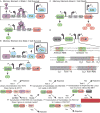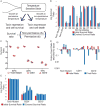Rational Design of Evolutionarily Stable Microbial Kill Switches
- PMID: 29149596
- PMCID: PMC5812007
- DOI: 10.1016/j.molcel.2017.10.033
Rational Design of Evolutionarily Stable Microbial Kill Switches
Erratum in
-
Rational Design of Evolutionarily Stable Microbial Kill Switches.Mol Cell. 2018 Oct 18;72(2):395. doi: 10.1016/j.molcel.2018.10.002. Mol Cell. 2018. PMID: 30340025 No abstract available.
Abstract
The evolutionary stability of synthetic genetic circuits is key to both the understanding and application of genetic control elements. One useful but challenging situation is a switch between life and death depending on environment. Here are presented "essentializer" and "cryodeath" circuits, which act as kill switches in Escherichia coli. The essentializer element induces cell death upon the loss of a bi-stable cI/Cro memory switch. Cryodeath makes use of a cold-inducible promoter to express a toxin. We employ rational design and a toxin/antitoxin titering approach to produce and screen a small library of potential constructs, in order to select for constructs that are evolutionarily stable. Both kill switches were shown to maintain functionality in vitro for at least 140 generations. Additionally, cryodeath was shown to control the growth environment of a population, with an escape frequency of less than 1 in 105 after 10 days of growth in the mammalian gut.
Keywords: CspA; antitoxin; cold shock; containment; kill switch; lambda; library; promoter; synthetic biology; toxin.
Copyright © 2017 Elsevier Inc. All rights reserved.
Figures







Comment in
-
Synthetic biology: License to kill.Nat Chem Biol. 2018 Jan 16;14(2):107. doi: 10.1038/nchembio.2561. Nat Chem Biol. 2018. PMID: 29337965 No abstract available.
References
-
- Angeles L. Heat-sensitive DNA-binding Activity of the cI Product of Bacteriophage Lambda. 1976;302:299–302. - PubMed
-
- Atwood BYKC. strain 15. 1951:146–155.
-
- Bläsi U, Young R. Two beginnings for a single purpose: the dual-start holins in the regulation of phage lysis. Molecular Microbiology. 1996;21(4):675–682. - PubMed
MeSH terms
Substances
Grants and funding
LinkOut - more resources
Full Text Sources
Other Literature Sources
Research Materials

